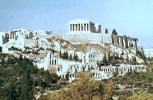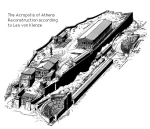The Athenian Acropolis |
The Athenian Acropolis |
 | The acropolis is a feature of Greek culture which reaches back as far as Mycenaean times when it was a fortress as well as a site for temples. The original Athenian acropolis had this defensive function also, with treasuries, armories, and official buildings as well as temples. In 480 B. C. the Persians captured the Athenian acropolis and burned the buildings to the ground. Initially, the Athenians decided to leave the ruins on the acropolis as a reminder of the barbarism of the Persians. However, several decades later they embarked on an ambitious rebuilding program initiated by Pericles and directed by Phidias, best known as a sculptor. The best architects and sculptors were involved in the program and the best materials were used -- such as marble for the buildings themselves (instead of limestone, which was more typical), and gold and ivory from Africa for the 42 foot high cult statue of Athena.
|
 | |
 | Although the Parthenon is the most famous building on the Athenian acropolis, it originally included an impressive entrance, a concert hall, libraries, freestanding sculpture throughout the site, and several other temples (among them, the Temple to Athena Nike). The organization of the buildings on the site is not, however, as unified as one might expect from the rational Greeks, partly because these buildings were reconstructed over earlier structures. |
All images marked MAS were photographed on location by Mary Ann Sullivan. All other images were scanned from other sources or downloaded from the World Wide Web; they are posted on this password-protected site for educational purposes, at Bluffton College only, under the "fair use" clause of U.S. copyright law.